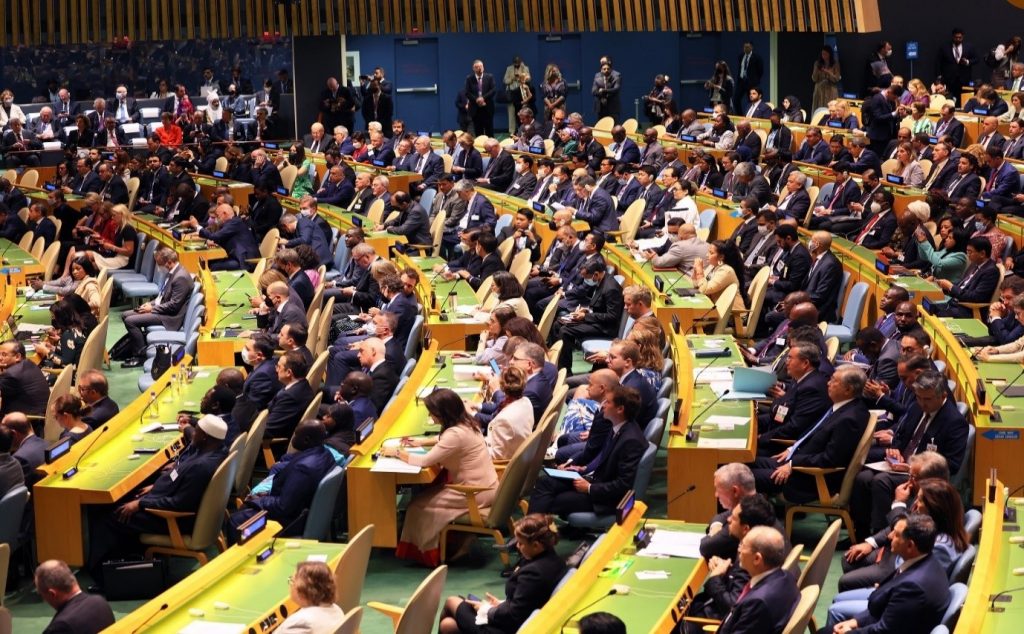
The United Nations General Assembly (UNGA) finally got back together in person, after three years of leaders speaking by video due to the global pandemic. This year’s session which took place in person for the first time since COVID-19 was declared a pandemic in March 2020 brought together world leaders, advocates, and influencers to find solutions to shared problems.
The gathering happened “at a time of great peril”, with the world “blighted by war, battered by climate chaos, scarred by hate, and shamed by poverty, hunger, and inequality. The theme for the forum was, “A watershed moment: transformative solutions to interlocking challenges.” The theme stems from the recognition that the world is at a critical moment in the history of the United Nations due to complex and interconnected crises, including the COVID-19 pandemic, the war in Ukraine, worsening global poverty, assaults to human rights, a tipping point in climate change as well as growing concerns about threats to the global economy. Food security was another major topic for the global forum, with the world economy hard-hit by the pandemic, inflation, and struggling supply chains.
For the past two years, heads of state were allowed to submit video statements due to pandemic restrictions. The INERELA+ Acting Executive Director – Munya Mandipaza participated in person.
The UN Women Executive Director Sima Bahous lamented that the world needs women and girls’ leadership, their partnership, and their activism as 1 in 3 women experience violence in their lifetime. This number has remained unchanged for at least the past decade even though violence is preventable.
Determined that reaching children affected by HIV be made a top global priority, faith communities, and health leaders came together at a high-profile event held on the side-lines of the United Nations General Assembly in New York to mobilize action and find effective ways forward. The event highlighted innovative models developed by faith-based organisations that have substantially improved outcomes for children, showing that more can be done.
Father Richard Bauer of the National Association of Catholics Chaplains emphasised that we need people of faith working together with the same meaning, the same purpose and with connectedness, and most important of all things is “to treat the whole person”—the biomedical and the psychosocial aspects.
Loyce Maturu of Global Fund Advocates Network has grown up to be a champion for better care for children affected by HIV. Her sentiments when she addressed leaders at the event were that we need more than medicines if children are to take their treatment, survive and thrive. Additionally, there is a need for better health and psychosocial support to help clients to understand their condition, and treatment and for them to learn how to grow with HIV to feel confident, valued, and loved and to be able to achieve their hopes and dreams.
Chip Lyons, President, and CEO of the Elizabeth Glaser Paediatric AIDS Foundation highlighted that leaders who speak about children have great power and we should never miss an opportunity to speak about children. He went on to emphasise that Faith-based organizations have provided a significant proportion of HIV-related health care since the beginning of the AIDS epidemic, particularly in resource-limited settings. They have strong links with communities and are vital partners in working to shift opinions, reduce stigma, provide data-led evidence and reach the most marginalized in society who are often the most in need of lifesaving health services.
Ambassador John Nkengasong US Global Aids Coordinator and Special Representative for Health Diplomacy lamented that communities of faith are the megaphone of trust within their communities. It is through this trust we see increased uptake of paediatric treatment by more than 20% in rural settings. He assured his commitment to working with faith communities to address the gaps and barriers that are creating the alarming numbers seen in children. Over 70% of the 1.7 million children living with HIV are in just 10 African countries which makes ending HIV in children an achievable goal. If those ten countries act, almost three-quarters of the challenge could be overcome.
The UNAIDS Executive Director Winnie Byanyima pointed out that stigma, discrimination, punitive laws and policies, violence, and entrenched societal and gender inequalities are hindering access to care for women, adolescents, and children. Faith communities can be extremely effective at breaking down stigma and calling for changes in laws and policies to ensure all people, including children, are safe and protected as they access HIV services. It is caring and compassion that changes lives and mindsets. In every community, in every country, faith communities are trusted, respected and listened to in ways others are not. The ability of faith communities to influence how people understand and react to HIV is unparalleled which makes them crucial and central to this work.
Byanyima indicated that one of the biggest challenges is finding children living with HIV who were not diagnosed at birth or during breastfeeding and linking them to treatment. It is concerning that only 63% of HIV-exposed infants in 2021 were tested by two months of age. Without treatment, 50% of infants with HIV will die by two years of age. In closing, Byanyima pointed out that new ambitious targets for diagnosing children and linking them to care have been set for 2023 and 2025, and a new Global Alliance to End AIDS Among Children has just been launched, which aims to end AIDS in children by 2030. In all of these efforts, faith communities play an invaluable role in helping governments, international organizations, communities of people living with HIV, service providers, and many others to achieve the new targets and end AIDS by 2030.
